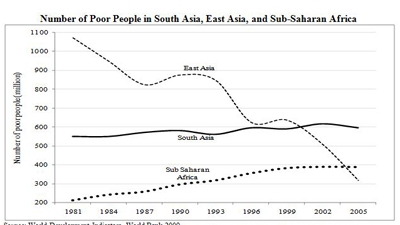Growth and poverty
The number of poor people (defined as those living under $1.25 per day) in South Asia increased from 549 million in 1981 to 595 million in 2005. In India, where almost three-quarters of these poor reside, the numbers increased from 420 million in 1981 to 455 million in 2005. South Asia’s poverty rate fell from 60% in 1981 to 40% in 2005. But it did not fall fast enough to reduce the total number of poor people.
So, have poverty trends in South Asia underperformed the global trends? No, South Asia matches the global trend. India, Sri Lanka, and Bangladesh all have poverty reduction precisely in line with what economic growth would predict. But merely matching the global trends may not be enough for a region which has the largest concentration of poor people. South Asian countries have not done as well as China and Thailand, for example.
Why does India lag behind China?
Why has India – with roughly the same population as China – not done as well as China at alleviating poverty? The poverty rate depends on income growth and how it is distributed across people – in other words, inequality. India has experienced slower economic growth relative to China, which partly explains the higher poverty rate.
What about inequality? Both China and India have experienced an increase in inequality, and inequality in China has increased more rapidly than in India. Despite this, China managed to reduce poverty faster than India, because it has grown faster.
Growth and social progress
What about social progress? Has it kept up with the pace of income growth? I compare changes in education, health, and gender outcomes in South Asia, conditional on income growth, with the rest of the world. The story is mixed.
South Asia has experienced an improvement in adult literacy that matches the global norm. However, the region lags behind when it comes to secondary education, which is becoming more relevant than primary education as growth becomes increasingly skill-intensive in the region. The experience of India in secondary education matches the global trend, but it has not done as well as China. India’s growth enrollment ratio in secondary school is 40%, compared with 70% in East Asia.
Health indicators have not kept up with income growth. Despite unprecedented economic growth, South Asia has the highest rates of malnutrition and the largest numbers of undernourished children in the world. Undernourished children have higher rates of mortality, have lower cognitive and school performance, and are more likely to drop out of school.
Growth and gender disparities
Over the last 50 years, the role women play in the economy and society has been revolutionized. Around the world, the most striking forms of inequality, which include discrimination against women in access to education, health, employment, political voice, and resources within the household, have been largely reversed. Nevertheless, dramatic gender inequities persist in South Asia.
Boys outnumber girls in school enrolment. Dropout rates for girls across the region are higher than those for boys. Dowry puts pressure on families of girls to marry them early, leading to preference for sons. Legal and judicial systems, as well as law enforcement mechanisms, have failed to address the high incidence of violence against women. Death rates for young girls are much higher than boys. Higher death rates for young girls are symptomatic of a general pattern of discrimination against girls. The expectation that girls will grow up to do little other than serve their husbands reduces a parent’s incentive to invest in their daughter's human capital. Uneducated women then have few alternatives and so the expectation becomes self-fulfilling, leaving women in a continuous circle of neglect. Gender disparities, which begin at childhood in the region, have significant adverse long-term effects. Women and girls bear the largest and most direct costs of these disparities.
Despite robust economic growth, women’s labor-force participation rate in the region is among the lowest in the world. In most cases, gender disparities in employment are reduced with a nation’s income growth. But growth in the South Asia region seems to be less gender-inclusive. Pakistan and India have a low ratio of female employment for their stage of development.
Prescription for policymakers
The paradox of South Asia is that growth has been instrumental in reducing poverty rates, but poverty rates have not fallen fast enough to reduce the total number of poor people. Poverty reduction in India, China, Sri Lanka, and Bangladesh is precisely in line with what economic growth would predict. Although inequality increased more rapidly in China than in India, China still managed to reduce poverty faster than India, due to a faster pace of income growth.
So the conventional wisdom that growth is important for poverty reduction is consistent with the empirical facts in South Asia. Growth creates the fiscal and political space for poverty reduction. However, the alternative view that growth tends to be incomplete is also consistent with empirical facts. The South Asian story on social progress – human development and gender disparities – is mixed. Human and social outcomes – education, health, and women's participation in economic activities – have not kept up with income growth. In this sense, growth may not be adequate.
Policymakers should consider direct policy interventions to accelerate social progress, with a particular focus to enhance gender inclusiveness. Major initiatives to increase the role of women can transform society. If more girls had gone to school a generation ago, millions of infant deaths could have been averted each year, and tens of millions of families could have been more educated, healthier, and happier.
Ejaz Ghani is economic advisor in the Poverty Reduction and Economic Management unit of the World Bank. This article is excerpted from his book, “The Poor Half Billion in South Asia: What Is Holding Back Lagging Regions?” An earlier version appeared on the website Vox.

